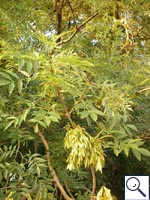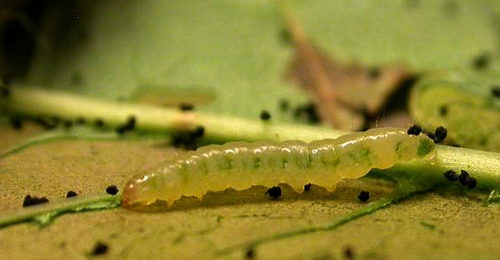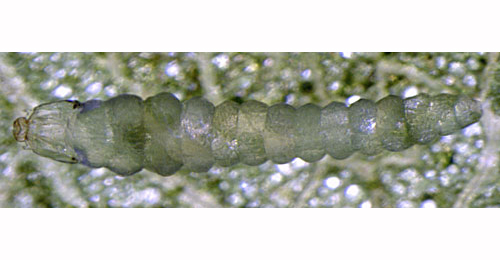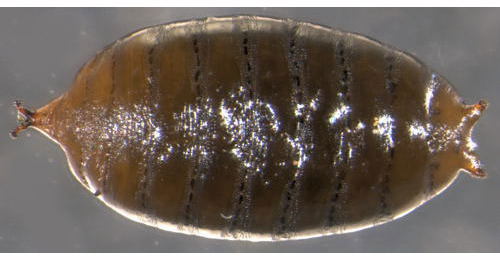|
||||||
|
FRAXINUS. Ash. [Oleaceae] |
|
|
Five British miners are recorded on Fraxinus. A key to the European miners recorded on Fraxinus is provided in Bladmineerders van Europa. |
 Ash Fraxinus excelsior |
Key for the identification of the known mines of British |
1a > Leaf-miner and case-bearer: The larva lives outside the mine, protected by a case, and feeds on the underlying plant tissues via a hole cut in the epidermis. From that point it eats away as much leaf tissue as it can reach without fully entering the mine. Mine does not contain frass (Coleophora species) |
1b > Leaf-miner, but not a case-bearer: The larva lives mainly inside the mine. Mine usually contains frass. In later instars the larva may live sandwiched between two more or less circular sections cut from the leaf. |
2 > Leaf-miner and case-bearer: The larva initially forms a gallery along the midrib, which then goes out along a vein. The end of this gallery is then excised to construct the first case. It then feeds close to this and makes several small mines. The final case is a small, laterally compressed, squat, spatulate leaf case of 5-6 mm. The dorsal keel has some serrations, remnants of the leaf margin out of which the case was cut. The rear is twovalved, and remarkably broad. The mouth angle is 0-10°. The description and illustration of the final case in Emmet et al. (1996a) is not quite clear. They depict a rather slender case, and state that the mouth angle is 30°. But, as the only illustration in the other literature that would agree with the British badiipennella, they refer to Hering (1957a, fig. 701): this illustration, however, has no resemblance to their own figure, and has a mouth angle of c. 0°. Emmet et al. write that the larva begins its life by making a gallery of 10-15 mm that runs from the midrib along a side vein; out if this mine the first youth case is excised. |
|
Coleophora badiipennella (Duponchel, 1843) [Lepidoptera: Coleophoridae]. |
3a > Leaf-miner: Initially an epidermal mine on the upper surface of the leaf, later the mine starts to contract and the leaf concealing the mine. Now the larvae leave the mine and live freely in a downwards rolled leaflet (Catalogue of Belgian Lepidoptera). Larva solitary in an elongate upper-surface epidermal (thence silvery) mine. Frass initially in a rust-coloured central line. Later, when the mine starts to contract and the leaf folds over the mine, the frass is black and concentrated in a corner of the mine. At this point the larva leaves the mine, and starts living freely in a downwards rolled leaflet. The mine can be distinguished from that of G.syringella on the same plant as it is a silver colour whereas that of G.syringella is brownish. Pupation in a flimsy white cocoon, attached hammock-wise within the final cone (Catalalogue of Belgian Lepidoptera). |
 Caloptilia cuculipennella larva, lateral Image: © Chris Snyers (Bladmineerders van Europa) |
|
Caloptilia cuculipennella (Hübner, 1796) [Lepidoptera: Gracillariidae]. |
3b > Leaf-miner: Larvae usually gregarious. Early mine an epidermal gallery leading to a contorted blotch with black frass. Subsequently two successive cones formed by folding the tip of a leaf downwards, as Caloptilia syringella). Often, many leaves on a single bush turn brown and curl up with the mines. The species can be a pest in gardens. The mine begins at a row of eggs along the midrib. The emerging larvae form relatively broad, inconspicuous, lower-surface corridor. Subsequently a large, grey brown or greenish brown, very opaque upper-surface blotch is made, occupied by ten or more larvae. The mine makes the leaf somewhat bumpy, but the leaf does not fold around the mine, like in Caloptilia cuculipennella. After some time the larvae leave the mine and continue feeding, still comunnally, in a downwards rolled leaf. |
 Gracillaria syringella larva Image: © Willem Ellis (Bladmineerders van Europa) |
|
Gracillaria syringella (Fabricius, 1794) [Lepidoptera: Gracillariidae]. |
3c > Leaf-miner: As a smaller larva it mines a leaf, but feeds on the buds of ash in its later stages. In late autumn the larvae make an irregular small corridor with dispersed black frass. Often the corridor widens in the end into an irregular blotch with much less frass. The mine may begin at an egg shell (lower picture), but the larvae can leave their mine an start a new one elsewhere in the leaf; in that case the corridor begins with a small round opening. Before the leaf is shed the larva leaves the mine and bores into the bark, where it hibernates. After hibernation they live as shoot borer, or free among spun leaves. The larva mines the bark of a twig and overwinters in this. In spring it bores out the terminal shoot - causing it to droop. |
|
Prays fraxinella (Bjerkander, 1784) [Lepidoptera: Yponomeutidae]. |
3d > Leaf-miner: A short linear-blotch mine, beginning with a small yellowish-brown pustule. Pupation external (Spencer, 1976: 315, 317 (fig. 569)). Greenish, later blackish, tortuous or irregularly star-shaped, upper-surface corridor, rather strongly widening in the end, and usually forming a secondary blotch. Frass in the first part of the mine in two ill-defined rows. Primary and secondary feeding lines present, but short and criss-cross. Pupation within the mine; the anterior spiracles penetrate the upper epidermis. The mine is an upper surface linear mine, becoming a blotch, with two rows of frass. |
 Aulagromyza heringii puparium Image: © Willem Ellis (Bladmineerders van Europa) |
|
Aulagromyza heringii (Hendel, 1920) [Diptera: Agromyzidae]. |
| Last updated 13-Jul-2019 Brian Pitkin | ||
